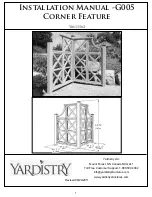
Documents are only to be used and distributed completely and unchanged. It is strictly the users´ responsibility to check
carefully the validity of this document with respect to his product. Manual-no.: 999084 / 05/10/2009
page 24 of 46
non-return valve closed
non-return valve open
Notes: If the system pressure is increasing, the port with the lowest preset pressure is closed at first. At
decreasing system pressure the port with highest preset pressure is opened at first.
Manually controlled vacuum applications:
In general: Avoid parallel processes which differ strongly in their demands concerning pumping speed or
ultimate vacuum as well as their simultaneous operation.
If several manually controlled ports are operated simultaneously, it is recommended to install a flow control,
such that the required process pressures of the applications are just attained. The permanent gas flow
through the hand-controlled ports has the same effect as a leak and leads to an increase of pressure in the
system.
If the pressure in the network exceeds the preset pressure of a parallelly operated application, the non-
return valve of that port closes. Such the application is protected against contamination or backflow, but it
is no longer possible to evacuate or control the application!
Remedial action: Further reduction of gas flow at the manual port is necessary until the system pressure
in the network is decreased below the lowest process pressure of a parallel application.
Automatically controlled vacuum applications:
An increase of system pressure due to formation of gas (e.g. pumping down) and/or programmed preset
pressures can occur if several automatically controlled ports of a vacuum network are operated
simultaneously. Such an increase of pressure usually occurs in form of a pressure peak. Therefore the
vacuum supply of parallelly operated applications is cut off only temporarily; the non-return valves counteract
the mutual interference.
In general: It is recommended to reduce the pumping speed at automatically controlled ports as well using
an additional flow control. By that means pressure bursts on the application side or in the vacuum network
are minimised. The hysteresis (
Δ
p) at the vacuum controller at the port should not be set too low (
Δ
p=
approx. ±10%p
Set
), if possible use the automatic hysteresis preset at the controller.
Notes: If the system pressure is increasing, the port with the lowest preset pressure is closed at first. At
decreasing system pressure the port with highest preset pressure is opened at first.
Effect of the integrated non-return valves:
At each port a non-return valve is integrated to avoid an increase of pressure or contamination. The preset
pressures of the different applications are related to the system pressure in the vacuum network as shown
below:
e
v
l
a
v
n
r
u
t
e
r
-
n
o
n
f
o
s
u
t
a
t
s
)
r
a
b
m
(
k
o
w
t
e
n
m
u
u
c
a
v
l
a
c
o
l
n
i
e
r
u
s
s
e
r
p
m
e
t
s
y
s
e
r
u
s
s
e
r
p
t
e
s
e
r
p
)
r
a
b
m
(
0
2
0
4
0
6
0
8
0
0
1
0
2
1
0
4
1
0
6
1
0
8
1
0
0
2
0
2
2
0
4
2
0
6
2
0
8
2
0
0
3
1
n
o
i
t
a
c
i
l
p
p
a
0
5
2
2
n
o
i
t
a
c
i
l
p
p
a
0
0
1
3
n
o
i
t
a
c
i
l
p
p
a
5
3
















































